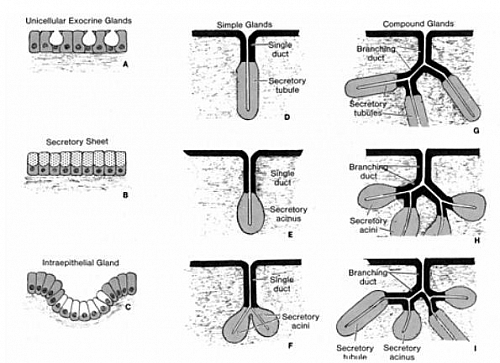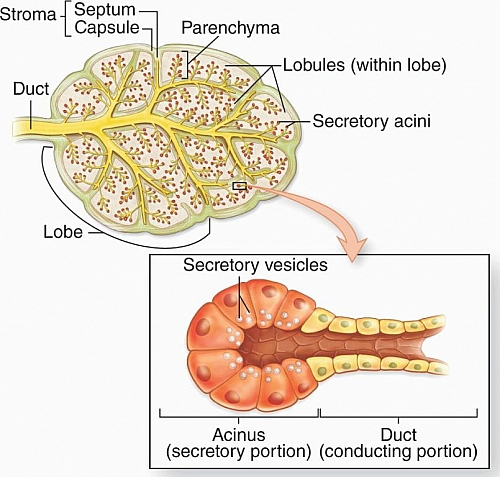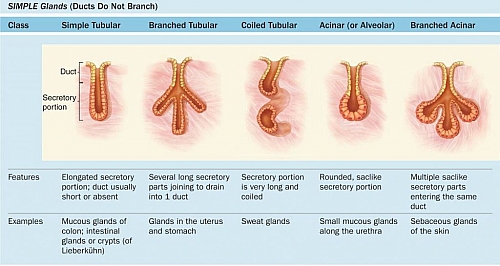Glands are considered as specialized epithelial cells that are adapted specifically for the purpose of secretion. This means in addition to performing functions such as protection and absorption, the cells of epithelial tissue also may secrete chemical substances. Therefore, no matter how complex a gland may be, it was first derived from epithelial tissue. Some complex glands originate in an epithelial surface and become detached from the surface epithelium the broad classification of glands into two major classes is based on this factor whether the gland still retains a connection with the epithelial surface of origin through ducts (hence are called Exocrine glands or Externally secreting glands) or the glands have no connecting ducts with the epithelial surface of origin (hence are known as Endocrine glands or Internally secreting glands).
Table of Contents
Functions of Glands in the Human body
The function of all glands is basically secretion of substances; but the individual functions of each gland depends on the substances secreted and the target areas or organs.
Specific Functions of some glands in the human body
- Salivary glands produces saliva that contains some enzymes for digestion of food and makes food palatable. Saliva also contains some antibacterial proteins.
- Lacrimal gland produces tears that help to bath the eyes, thereby serving as a lubricant and it contains antibacterial property.
- Mammary gland responsible for the production of breast milk especially in females
- Prostate gland produces some substances that help to add secretions to the sperm before release
- Sebaceous gland produces sebum that helps to oil the hair and skin making them moist,
- Sweat gland (also called Sudoriferous or sudoriparousglands) produces sweat that helps to cool off the body and therefore helps in regulation of body temperature through the process of perspiration
- The pancreas this is both an exocrine and an endocrine gland. The exocrine portions secrete digestive enzymes that are carried by ducts to the duodenum of the small intestine while the endocrine portions of the pancreas called pancreatic islets or islets of Langerhans, secrete two hormones: insulin and glucagon directly into the blood that help in the regulation of blood glucose.
- Adrenal glands located above the kidneys and produces hormones: adrenaline and noradrenaline whose functions are in regulating the response of the body to threats and this can be in different forms such as increasing the blood pressure via vasoconstriction, can also increase heart rate and also increase glucose level of blood and so much more. It is called the fight and flight hormone.
- Pineal gland this is a small, pea-shaped gland located in the human brain that produces and regulates some hormones such as melatonin which in turn regulates sleep patterns.
- Thyroid glandsecretes thyroxine and helps in regulation of the body metabolism.
- Gastric glands secrete gastric juice whose function is to aid in digestion.
- Pituitary gland (also known as the Hypophysis or Master gland it controls many other glands) produces several releasing hormones that further controls many of bodys functions such as growth, blood pressure, uterine contractions, breast milk production, thyroid gland function, water and osmolarity regulation in the body, water balance via the control of reabsorption of water by the kidneys, temperature regulation and pain relief
- Parathyroid glands (four tiny glands located in the neck) produces parathyroid hormone which controls the level of calcium in the blood and bones.
- Ceruminous glands these are sebaceous glands and modified apocrine sweat glands found in the outer third of the cartilaginous portion of the human ear canal and are responsible for the production of Earwax (also known medically as Cerumen). Cerumen plays a vital role in the human ear canal by assisting in cleaning and lubrication of the ear as well as protection from bacteria, fungus, and insects.
- Bulbourethral glands (also known asCowper glands) add fluid to semen
Classification of Glands
Glands can be classified according to their histologic organization, type of substance secreted and manner in which the substance is secreted and whether they have ducts or not.
- Classification according to Histology: this could be glands with only a single cell called Unicellular glands or glands with aggregate of secreting cells called Multicellular glands.
- Classification according to presence or absence of ducts: this can be divided into Exocrine glands which secrete onto a surface or into a ductal system and Endocrine glands which secrete directly into fluid of the intercellular space. Also, Complex exocrine glands can further be subdivided based on the branching of their ducts, the type and mode of secretion and also by the configuration of the secretory end piece.
Table showing the description of each Type of Gland with their examples
| Type of Gland | Examples of Glands |
| Unicellular Glands | |
| Exocrine | Goblet cells |
| Endocrine | Gastrin-cells and other unicellular endocrine cells within the epithelial lining
of the digestive and respiratory systems |
| Multicellular Exocrine Glands | |
| Secretory sheet | Surface epithelium of gastric mucosa (gastric lining epithelium) |
| Intraepithelial glands | Urethral (Littres) glands |
| Simple tubular glands | Intestinal glands |
| Simple coiled tubular glands | Eccrine and apocrine sweat glands |
| Simple branched tubular glands | Esophageal glands, pyloric glands |
| Simple branched alveolar glands | Meibomian glands, sebaceous glands |
| Compound tubular glands | Brunners glands |
| Compound tubuloacinar glands | Salivary glands, pancreas |
| Compound alveolar (saccular) glands | Prostate gland |
Unicellular Glands
Unicellular glands are interspersed amongst other (non-secretory) epithelial cells. The classic example of a unicellular exocrine gland is the goblet cell that is located in the epithelial cells lining the trachea, small intestine, and colon. The goblet cell has a narrow base and an expanded apex filled with secretory granules. These Goblet cells secrete a protein known as mucin that when mixed with fluid produces mucus which helps in lubrication of the organs in which these goblet cells are found. Since the mucin is secreted onto an epithelial surface, the goblet cell is therefore classified as a unicellular exocrine gland.
Unicellular endocrine cells (glands) also occur and are numerous in the epithelial lining of the gastrointestinal tract. These glands help in the production of some peptide hormones and amines. They are also found in the epithelium lining the respiratory system and are responsible for the secretion of substances into the extracellular space the product of which may enter the adjacent vasculature.
Multicellular Glands
An example of multicellular exocrine gland is the secretory sheet of the epithelial lining of the stomach of which the cells form a continuous epithelial layer. Other forms of multicellular exocrine glands in the stomach are the intraepithelial glands that form small clusters of secretory cells that lie wholly within an epithelial sheet, clustered about a small lumen. The cells of both types of gland secrete their product onto the epithelial surface hence they are exocrine in nature.
Complex Exocrine Glands
Exocrine glands secrete onto a luminal epithelial surface either directly (such as in secretory sheets and intraepithelial glands of the stomach) or by a ductal system. In a ductal system of complex glands, whenever there is branching of the ducts, the gland is said to be compound gland; if the duct system does not branch, the gland is known as a simple gland.
The secretory cells may be organized into different forms such as tubules (the tube may be straight, coiled, or branched), acini (rounded sacs), alveoli (with berry-like end pieces), or saccules (with dilated, flask-like end pieces). These organization of the secretory cells are also used in the classification of complex exocrine glands. Therefore, simple and compound glands can be named by the shape of the secretory portion this means, simple glands can be classified as simple tubular, simple coiled tubular, simple branched tubular, or simple branched acinar gland. Also, compound glands can be subdivided into compound tubular, compound saccular, and compound tubuloacinar (tubuloalveolar). The initial subdivision into simple and compound is made according to whether or not the ducts branch. Subsequent classification depends on the shape and configuration of the secreting portion (the secretory unit).
It should be understood that the epithelial cells forming the closely packed tubular structures of complex glands remain arranged as a single layer of cells despite the complex appearance of the overall glandular structure this helps in organizing the secretory cells into the smallest area possible.
Endocrine Glands
Endocrine glands lack ducts and secrete substances called Hormones. Like exocrine glands, the complex endocrine glands also arise from an epithelial sheet but lose their connections with the epithelial surface during their formation, making them ductless in nature. Cells of endocrine glands secrete substances known as hormones that regulate target areas of the body. The hormones released may target and stimulate the releasing cell itself this type of secretion is known as Autocrine secretion; the secretion may target and stimulate adjacent cells and this is called Paracrine secretion; or the secretion may enter the blood to target specific cells of distant organs. There are some scattered, solitary endocrine cells found in the gastrointestinal tract and along the conducting portion of the respiratory tract.
The structure of the complex endocrine glands is so diverse that their histologic classification is difficult. However, some overall structural patterns can be made out, and the cells may be arranged as clumps, cords, or hollow spherical structures called follicles.
Classification of Glands according to their Type of secretion and Mode of Secretion
(A). Classification of glands according to the type of material secreted
Glands can also be classified as mucous, serous, or mixed according to the type of material secreted. Cells of Mucous glands have pale, vacuolated cytoplasm and flattened, dense nuclei oriented toward the base of the cell whereas Serous cells show round nuclei surrounded by a basophilic cytoplasm that contains discrete secretory granules. Mixed glands contain variable proportions of serous and mucous cells combined.
(B). Classification of glands according to mode of secretion
Two types of glands can be distinguished by their mode of secretion. These include Merocrine and Holocrine.
Merocrine secretion(also called Eccrine or Epicrine) refers to release of substances through the fusion of secretory vesicles with the apical plasmalemma and can be seen as a regulated form of exocytosis. Merocrine secretion is the most common type of exocrine secretion.
Holocrine secretion involves the release of whole cells such as release of spermatozoa from the testes or the breakdown of an entire cell to form the secretion such as release of sebum in sebaceous glands.
There is a third type of secretion known as Apocrine which is described as a loss of the portion of the apical cytoplasm along with the secretory material. Electron microscopy has failed to support this mode of secretion except perhaps for the mammary glands during lactation and secretion of sweat from some atypical sweat glands.
Myoepithelial Cells
The secretory units of some glands are associated with myoepithelial cells, which are specialized cells located between the glandular epithelial cells and the basal lamina. The myoepithelial cells are contractile and their cytoplasm contains actin and myosin arranged in a similar manner to those of smooth muscle cells these proteins are responsible for the contractile function of these cells. The myoepithelial cells also contain the intermediate filament, desmin. Long cytoplasmic processes extend from the body of the cell to course around the secretory unit. The contraction of these cells help in expressing products from the secretory units into the ductal system. Myoepithelial cells are found in sweat, mammary, and salivary glands and in glands along the bronchi and esophagus.






